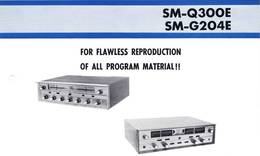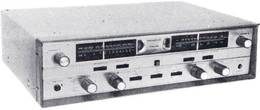Das Prospektblatt des model SM-Q300E /model SM-G204E
FOR FLAWLESS REPRODUCTION OF ALL PROGRAM MATERIAL!!
STEREOPHONIC TUNER AMPLIFIERS
model SM-Q300E model SM-G204E
These units are professional quality stereophonic tuner-amplifier combinations capable of providing efficient and powerful reception of all forms of "radio broadcasts" including AM medium wave (Mittelwelle), AM shortwave (Kurzwelle), AM longwave (Langwelle), and FM (UKW) transmissions. They represent a crystallization of PIONEER'S extensive experience and the ultimate in electronic technology, to provide supreme performance and versatility.
The preamplifier sections use carefully-selected components. Coupled with the outstanding overall design of the amplifiers, the top quality components and up-to-date design and circuitry are given full play in playback of disc and tape recordings or reception of radio broadcasts, to produce full stereo effects and flawless sound.
The output circuits use the latest high-efficiency output tubes operating in powerful pushpull circuits, for stable distortion-free power.
These amplifiers are ideal as integrated stereophonic amplifiers for home use, with their abundant auxiliary circuits including filters and other supplementary features.
Features of the Pioneer SM-Q300E
.
- The output circuits are comprised of two pairs of the popular EL-84 6BQ5 type tubes operating in pushpull circuits, for a full 17 watts of output per channel, and distortion is kept at an absolute minimum.
- The power rectifier circuit is a voltage-doubler circuit using silicon diodes, for good regulation, to provide stable signal output. All forms of filters are provided. These include a scratch filter, a whistle filter, and a rumble filter, for effective elimination of all unnecessary noises.
- The SM Q300E is equipped with a mode blend control, a PIONEER-patented circuit. The spread of stereophonic sound can be controlled freely, while the transition from stereo to mono can be accomplished over a continuous scale using a single control knob.
- The inputs provided are MAG for magnetic pickups, XTAL for crystal or ceramic pickups, MIC for microphone, TAPE for tape playback, and AUX for other auxiliary sources. These all provide maximum versatility in every possible application.
- The loudness control can be switched on or off at will by means of the switch provided.
- A jack for simultaneous recording on tape of program material is provided. This makes possible recording on tape of the program material being listened to.
- The rich appearance featuring a heavy gold-finished aluminum panel will match and enhance any room the amplifier is used in.
.
SPECIFICATIONS OF THE Pioneer SM-Q300E
| Tubes Used: | 19 tubes, 6 diodes (19 Röhren !!!) | ||
| TUNER SECTION | ------------------------------------------------- | ||
| Frequency Range : | Broadcast band (Mittelwelle) 535-1,605 Kc (kilo-cycles) | ||
| Shortwave band 5-15 Mc (mega cycles) | |||
| Longwave band 150-360 Kc (kilo cycles) | |||
| FM band (UKW) 88-108 Mc (unser UKW) (in mega cycles) | |||
| Max. Sensitivity : | Broadcast band (Mittelwelle) 15uV | ||
| Shortwave band 20uV | |||
| Longwave band 50uV | |||
| FM band (UKW) 10uV | |||
| Supplementary Circuits | AFC (FM only), for FM multiplex adaptor | ||
| AUDIO SECTION | ------------------------------------------------- | ||
| Inputs & Gain : | MAG. Phono | 3.4 mV | |
| XTAL. Phono | 38 mV | ||
| MIC | 4 mV | ||
| TAPE (Play) | 160 mV | ||
| AUX | 160 mV | ||
| Signal to Noise Ratio | MAG phono ; better than 50 db | ||
| Outputs (for Speaker) | 4, 8, 16 ohms (per channel) | ||
| For center channel, For tape recording | |||
| Max. Power Output | 17 watts per channel | ||
| Frequency Response | 20—50,000cps, ±1 db | ||
| Residual Hum & Noise | 0.5 fi\N | ||
| Voltage & Cycles | 115/230 volts, 50/60 cycles | ||
| Max. Power Consumption | 170 VA | ||
| Dimensions : | 18"(W) x 13"(D) x 5"(H) inch | ||
| Weight : | 36 lbs (16 Kilo) |
.
Anmerkung zu den deutschen Texten der frühen Produkte:
.
- Anmerkung 1 : Die damaligen Übersetzer hatten große Probleme, diese neuen technischen Begriffe zu übersetzen. Woher sollten sie die Ahnung haben, was bei uns ein "broadcast band" ist. In den USA war das der generelle Begriff für das (Frequenz-) Band mit den zu empfangenden Sendern, also die Mittelwelle. "Short-wave" und "long-wave" waren ja eindeutig. Und UKW (FM) kam ja in den USA erst mit etwas Verspätung, nachdem Deutschland quasi gezwungen wurde, auf andere Wellenbereiche auszuweichen und ab 1951 - quasi mit Gewalt - UKW eingeführt hatte.
Dafür hatten die Amerikaner das mit diesem "Multiplex Stereo" mit Pilotton wieder ein paar Jahre früher als wir hier in Deutschland. - Anmerkung 2 : Auch die Angabe der Ausgangs-Leistung "variiert" je nachdem, was der Ingenieur oder Entwickler gerade so aufschrieb. Erst viel später wurde zumindest zwischen der RMS (Dauer-) Leistung und der (oftmals fiktiven) Musikleistung unterschieden. Auch war die Angabe immer ein Mischmasch - mal die Summe beider Kanäle, die aber einzeln gemessen und dann verdoppelt wurden, mal wirklich die Leistung eines Kanales - aber ganz alleine und erst viel später wirklich die echte Leistung bei gleichzeitigem Betrieb beider Kanäle.
.
Features of the Pioneer SM-G204E
.
- The high fidelity FM tuner section is equipped with an AFC circuit to provide stable reception of FM broadcasts, for full enjoyment of the best in high fidelity sound.
- The output circuits are each equipped with a pair of the latest ECL-86/6GW8 type tubes, to provide a full 14 watts of power per channel. Power output is extremely stable, and there is virtually no distortion.
- The input circuits are capable of handling all forms of input signals. These include the outputs from magnetic pickups, crystal or ceramic pickups, tape players, and other auxiliary sources. A jack is provided on the front panel for individual listening by means of a stereophonic headset and speaker listening is accomplished by means of a switch.
- A loudness control circuit that can be switched on or off whenever warranted is provided. The use of this circuit provides full high fidelity reproduction even at low listening levels. Scratch and rumble filters are provided, for elimination of unnecessary noises such as static or low frequency rumble, for clean enjoyable listening at all times.
- The number of control knobs has been kept down to a minimum, and see-saw type rocker arm switches are used, for maximum ease in operation.
.
SPECIFICATIONS OF THE Pioneer SM-G204E
| Tubes Used: | 18 tubes, 4 diodes (18 Röhren !!!) |
| TUNER SECTION | ------------------------------------------------- |
| Frequency Range : | Broadcast band 535-1,605 Kc |
| Shortwave band 5-15 Mc | |
| Longwave band 150-360 Kc | |
| FM band 88-108Mc | |
| Max. Sensitivity : | Broadcast band 20uV |
| Shortwave band 80uV | |
| Longwave band 50uV | |
| FM band 10uV | |
| Supplementary Circuits : | AFC (FM only), for FM multiplex adaptor |
| AUDIO SECTION | ------------------------------------------------- |
| Inputs & Gain : | MAG. Phono; 2.5 mV |
| XTAL. Phono ; 30 mV | |
| TAPE (Play) ; 200 mV | |
| AUX ; 200 mV | |
| Signal to Noise Ratio : | MAG Phono ; better than 50db |
| AUX ; better than 70db | |
| Outputs (for Speakers) : | 8 & 16 ohms (per channel) |
| For center speaker, For headphone, | |
| For tape recording | |
| Max. Power Output : | 14 watts per channel |
| Frequency Response : | 20-50,000 cps, ±1db |
| Residual Hum & Noise : | 0.5uW |
| Voltage & Cycles : | 115/230 volts, 50/60 cycles, 1.3/065 amps |
| Max. Power ConsumDtion : | 110VA |
| Dimensions : | 181/2(W)X131/1(D)X51/2(H) inch |
| Weight : | 29 lbs |




